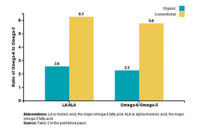
Good for All
With fluid sales
perpetually in need of a boost, it’s great to see IDFA on the team
that launched Bev Expo last month. This new trade show, which includes
participants from all corners of the beverage spectrum, offered a strong
dairy presence from exhibitors as well as educational programming.
I was lucky enough to be down in Tampa for the
expo, not only because the hurricanes were gone by then, but to hear the
preaching not just to the choir, but to the whole beverage community, that
opportunities for milk abound.
But then, what’s left to be said? Dairy Field has been at
the forefront of delivering the latest news of how milk stands poised as
the next great dietary lifestyle choice; another look at milk’s role
in the obesity debate can be found in this issue. And just last month, I
suggested to you that we stand at the cusp of a banner year for school
milk. One of the Bev Expo sessions I attended confirmed as much, and
outlined an ongoing series of nationwide workshops aimed at strengthening
the case for school milk.
But on new ideas, Bev Expo did not disappoint.
Among the dairy-related sessions was the presentation of a new strategy
under way, titled “Optimizing Space in the Dairy Case.” This
study from the Fluid Milk Strategic Thinking Initiative, presented by Rob
McCabe of Williard Bishop Consulting, looked at different dairy case
management ideas to increase sales.
The study led to the development of a computer
model aimed at helping retailers determine how to maximize space for fluid
sales by size, flavor, and type according to varying consumer needs. Its
mission is to combat the displacement of fluid products from dairy cases as
other products compete for space, leading retailers to shrink facing space
for products like white gallons. The goal is to reaffirm the historic
profitability of fluid milk as a staple of consumers and convince retailers
they shouldn’t be giving up ground to other products.
Yet another study, this one out of Texas A&M
University, provided cold, hard data for something of which I’m sure
the industry has been keenly aware for quite some time: milk’s
biggest competitor is pop, and dairy takes it on the chin when retail
prices jump.
Historically, analyses of milk sales have
understated the competitive forces in the marketplace and asserted that
demand for milk is inelastic, explained A&M’s Dr. Oral Capps. In
fact, Capps said, research shows milk loses more consumers to carbonated
soft drinks for every 1 percent increase in milk prices. On the other hand,
sales of bottled water appear to be fairly independent of milk.
So what does this mean? Well, much like Dr.
Zemel’s research showed us hard data on what we already knew, that
milk is good for you, the A&M study affirms the pattern of declining
fluid sales. And while milk is historically profitable as a sales driver in
the grocery arena, retailers apparently see it as expendable in the fight
for shelf space.
Thus the circle is drawn: Demand is low so prices
fall and production drops. Supply is short so prices rise and consumers
seek alternatives. Then as the wheel turns, wrenches like BSE and CWT get
thrown into the spokes.
Is market stability possible? Maybe, if the
industry takes advantage of the data being offered and attempts to
artificially stunt supply are halted. Stress to retailers the strength of
milk on sales and deliver them innovative, quality products. Stress to
consumers the strength of milk on health and taste, and deliver them
innovative, quality products.
Promote consistent demand, encourage consistent
prices. The commodities roller coaster isn’t good for anyone. df
$OMN_arttitle="Good for All";?>